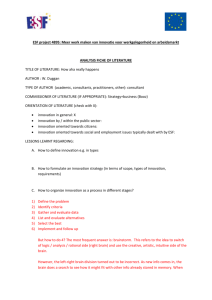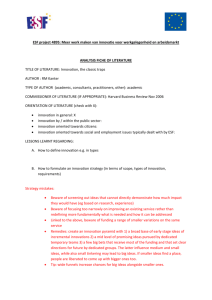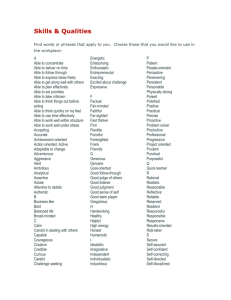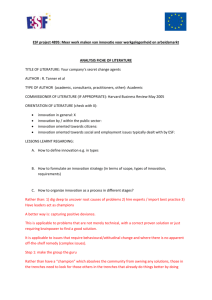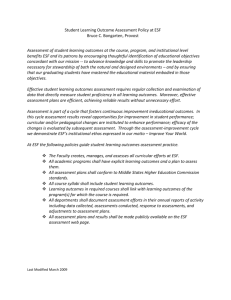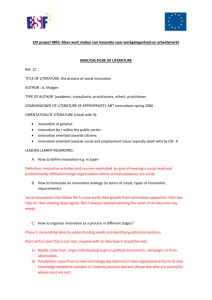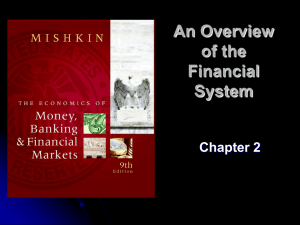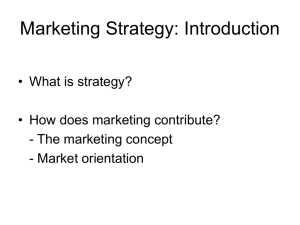ESF project 4895: Meer werk maken van innovatie voor
advertisement
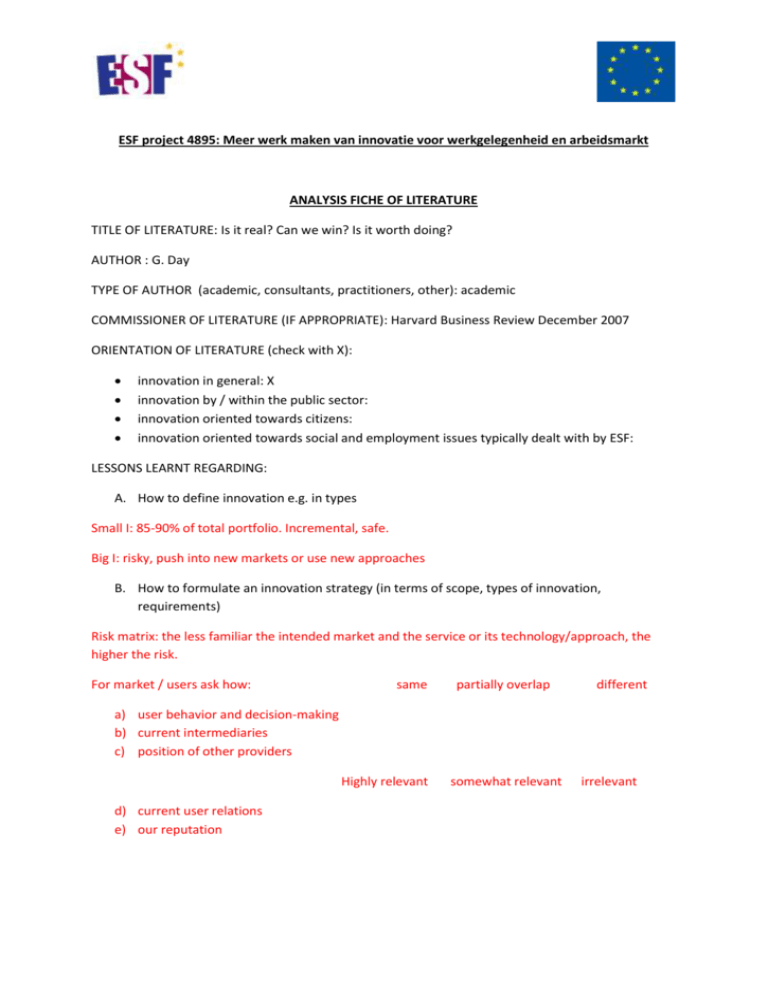
ESF project 4895: Meer werk maken van innovatie voor werkgelegenheid en arbeidsmarkt ANALYSIS FICHE OF LITERATURE TITLE OF LITERATURE: Is it real? Can we win? Is it worth doing? AUTHOR : G. Day TYPE OF AUTHOR (academic, consultants, practitioners, other): academic COMMISSIONER OF LITERATURE (IF APPROPRIATE): Harvard Business Review December 2007 ORIENTATION OF LITERATURE (check with X): innovation in general: X innovation by / within the public sector: innovation oriented towards citizens: innovation oriented towards social and employment issues typically dealt with by ESF: LESSONS LEARNT REGARDING: A. How to define innovation e.g. in types Small I: 85-90% of total portfolio. Incremental, safe. Big I: risky, push into new markets or use new approaches B. How to formulate an innovation strategy (in terms of scope, types of innovation, requirements) Risk matrix: the less familiar the intended market and the service or its technology/approach, the higher the risk. For market / users ask how: same partially overlap different a) user behavior and decision-making b) current intermediaries c) position of other providers Highly relevant d) current user relations e) our reputation somewhat relevant irrelevant For approach ask: fully applicable requires significant adaptation not applicable f) current development capabilities g) current approach h) current delivery system identical to current overlap somewhat not applicable i) The required knowledge bases j) The necessary service functions k) The expected quality standards Scales are always from 1 to 5 and subscales are added to find the total. This is then mapped onto an X (market similarity) and Y (service/approach similarity) axis. One can expect 75-95% to fail if both dimensions are “new”. Only 25-40% fail if both dimensions are similar to current. C. How to organize innovation as a process in different stages? D. How to define outputs of innovation e.g. in terms of idea, concept, prototype…? E. How to make decisions regarding progress of an innovation? The screen is elaborated for the early stages of a proposal, to test concepts. In later stages, testing prototypes and early in the launch would need modification of the details, not of the larger headings. The following questions need to be answered. A no to any of the five fundamental questions results in termination of the project. The sixth question is more forgiving. a) Is the market real? This question comes before the question “can we make it happen” as market robustness is almost always less certain. Failure tends to be greater if market is uncertain. Also, it is important to prevent a technology push that emphasizes how to solve a problem rather than whether and what problem should be solved 1. Is the market real? i. Need for the service? Surfaced through market research, ethnography,…to explore user behavior, desires, motivations, frustrations ii. Can the user access it / afford it? Objective barriers, regulatory requirements, … iii. Are there enough users? Will they use? What are subjective barriers? Why would they (not) want to switch from another service to this one? Eg because of habit, something else is on the horizon, perception it is risky to change, iv. Important to keep asking user oriented questions, especially if compromises are made in the service concepts, to see whether the appeal is still there. 2. Is the service real? i. A clear concept? What are the requirements for the service? ii. Can it be delivered? Can it be done within current approach with current resources? Or is a big change necessary? Can it be delivered /accessed cost-effectively? Or so costly no one would want to deliver/access it? Will required intermediaries/ complementary service providers cooperate? Is it legal/ within regulations? b) Can we make it happen? 1. Does the service have something better to offer than what exists? i. What is the superiority over a current service? Both in terms of tangible (lower costs, better achievement, …) and intangibles (social acceptability, reduced risk perception,…). ii. Is it sustainable (incl. in terms of financing)? iii. Will others want to offer the service? 2. Can we (and/or others) do it? i. Do we have the resources? Can we get them? ii. Do we have the management? Passionate go-between who can convince others? iii. Can we understand and respond to users? Do we have iterative feedback cycles foreseen? iv. What about others? How will they react? Is this good /bad? c) Is it worth doing? 1. What is the hoped for impact relative to risk? i. Cost-effectiveness ii. Risk: what could go wrong? What would be the consequence for costeffectiveness? 2. Does launching make strategic sense? i. Does the service fit within the overall strategic orientation? ii. Will it create opportunities to expand into new areas afterwards? F. What roles exist for different actors in the innovation process? What competences are required for these roles? G. How to organize interaction with external stakeholders (open innovation)? H. Specific tools that are explained (list briefly for each tool in what stage, by which role, why, how it is to be used). a) Tool 1:

